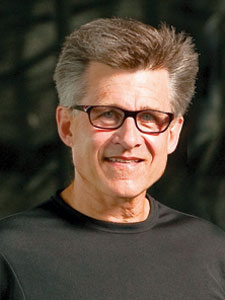Recent News
UNM Engineering team wins ASEE best paper for work on first-year engineering course
July 17, 2025
New director will enhance interdisciplinary engineering learning opportunities
July 2, 2025
Final SIRI cohort visits UNM campus
June 30, 2025
Perfetti receives ANS Landis Engineering Achievement Award
June 26, 2025
News Archives
New Membranes for Water Purification Technology Receives R&D 100 Award
July 5, 2011
 Clean water is a global problem. It is one of the most important issues facing the global community because it is critical to public health, agricultural and energy production. By 2025, clean water will be in severe shortage in places such as Africa, China, the Middle East, and India. That may be why a new technology jointly disclosed by researchers at the University of New Mexico (UNM) and Sandia National Labs (SNL) has received the prestigious R&D 100 Awards for the year’s 100 top high-technology inventions in applied technologies.
Clean water is a global problem. It is one of the most important issues facing the global community because it is critical to public health, agricultural and energy production. By 2025, clean water will be in severe shortage in places such as Africa, China, the Middle East, and India. That may be why a new technology jointly disclosed by researchers at the University of New Mexico (UNM) and Sandia National Labs (SNL) has received the prestigious R&D 100 Awards for the year’s 100 top high-technology inventions in applied technologies.
The joint invention competed against an international pool of technologies developed by industry, academia, private research firms and government labs. Winners were selected by the editors of R&D Magazine and an independent panel of judges. Called the “Oscars of invention,” the prestigious award often gives inventors the impetus they need to launch their emerging technologies into the marketplace.
The co-inventors for the technology, entitled Biomimetic Membranes for Water Desalination, are Susan Rempe, David Rogers, and S. Leung from SNL; Dr. Jeffrey Brinker, who hold a joint appointment at SNL and UNM as Fellow and Distinguished Professor in the Department of Chemical & Nuclear Engineering, respectively; (above) and Ying-Bing Jiang, Senior Research Scientist in the UNM Department of Earth & Planetary and Dr. Shaorong Yang, post-doctoral researcher in the UNM Department of Earth & Planetary Sciences.
Using biomechanisms patterned after a living cell membrane, the inventors have engineered a solution to better water desalination technology by creating a novel nanoporous synthetic material that is an improvement over reverse osmosis (RO) membranes. The new membrane is called biomimetic because it “mimics” nature.
Traditional polymeric RO membranes are expensive because they require such high pressures to drive the salty water through the filtration membrane. The challenge for the next generation of membranes is how to increase efficiency by designing materials that move water more quickly while maintaining a high level of salt and other mineral removal. Inspired by the molecular design principles of a living cell membrane whose protein channels provide a very efficient natural filtration system, the inventors have engineered nanochannels for desalination.
The technology uses an atomic layer deposition (ADL) process, a thin film deposition technique on the atomic scale that sequentially applies layers of chemicals to the surface of a substrate to produce a thin film.
The nanoporous material has twice the efficiency of an RO membrane because it has high salt rejection and improved water flux (the rate at which water permeates a membrane), even at pressures as low as 80 psi (pound per square inch). This breakthrough in material design means that it is possible to produce ultra-low pressure nano-filtration and RO water purification membranes that are highly efficient, representing a significant savings in energy costs.
The potential markets for the new membrane include agriculture, chemicals, medical devices, mining, storage battery and water supply and sewage treatment industry sectors.
The 49th Annual R&D Awards will be presented by R&D Magazine to recipients at an awards banquet to be held on October 13th in Orlando, Florida.
About Sandia National Laboratories
Sandia National Laboratories is a multiprogram laboratory operated and managed by Sandia Corporation, a wholly owned subsidiary of Lockheed Martin Corporation, for the U.S. Department of Energy’s National Nuclear Security Administration. With main facilities in Albuquerque, New Mexico, and Livermore, California, Sandia has major R&D responsibilities in national security, energy and environmental technologies, and economic competitiveness.
About the University of New Mexico
The mission of the University of New Mexico is to serve as New Mexico’s flagship institution of higher learning through demonstrated and growing excellence in teaching, research, patient care, and community service. UNM research injects millions of dollars into New Mexico’s economy, funds new advancements in healthcare, and augments teaching—giving students valuable hands-on training in state-of-the art laboratories. Offering more than 210 degree and certificate programs, UNM has 94 bachelor’s degrees, 74 master’s degrees and 40 doctoral programs. The Health Sciences Center is the state's largest integrated health care treatment, research and education organization.
About STC.UNM
STC.UNM (STC) (www.stc.unm.edu) is a nonprofit corporation formed and owned entirely by the University of New Mexico Regents (UNM). The mission of STC is to support UNM and its partners as the source of innovation management and commercial development. STC does this by connecting the business community to UNM; protecting and transferring intellectual property and faculty inventions to the commercial marketplace; and by assisting companies and organizations that wish to access facilities, expertise, and research conducted at UNM. As STC has evolved, the corporation has come to support not only UNM faculty, but students, outside inventors, and entrepreneurs as well. For additional information, contact Lisa Kuuttila at 505-272-7905 or kuuttila@stc.unm.edu.
About R&D Magazine
Since its founding in 1959 as Industrial Research, R&D Magazine has served research scientists, engineers and technical staff at laboratories around the world, providing timely, informative news and useful technical articles that broaden readers’ knowledge of the research and development industry and improve the quality of their work. R&D Magazine is a publication of Advantage Business Media (www.advantagebusinessmedia.com).
